The Influence of Aerosols on Satellite Infrared Radiance Simulations and Jacobians: Numerical Experiments of CRTM and GSI
Abstract
:1. Introduction
- cooler simulated BTs, which produce larger positive first-guess departures that then cause the warming features on the temperature analyses. The bias-corrected first-guess departures are utilized in QC.
- aerosol-affected Jacobians for surface temperature and surface emissivity, which are utilized by QC and BC algorithms, respectively. Moreover, the Jacobian for surface temperature is involved in the determination of sea surface temperature analysis.
- changes to the Jacobians for atmospheric states, which are not only involved in the minimization of the cost function to determine the analysis increments but also the cloud check in QC.
2. Models and Dataset
2.1. Gridpoint Statistical Interpolation (GSI)
2.2. Community Radiative Transfer Model (CRTM)
2.3. Atmospheric and Aerosol Dataset
3. Experimental Design
3.1. CRTM Sensitivity Tests
3.2. Single IR Observation Experiments
4. Results
4.1. Sensitivity of Simulated BTs
4.2. Sensitivity of BT Jacobians
4.3. Single IR observation Test
5. Discussion and Conclusions
- Dust aerosols generate stronger impacts on BTs than other species (Figure 3). For other aerosol species, their influences could be limited on BTs due to the relatively smaller particle size and extinction coefficients.
- An aerosol layer with heavier loading that peaks at higher altitude can produce the strongest cooling to simulated BTs (Figure 4). In contrast, the thickness and the bin partition of an aerosol layer provide smaller influences on simulated BTs.
- The aerosol-induced differences in atmospheric Jacobians produce considerable changes (∼25%) to analysis increments for specific humidity and temperature (Figure 10). In particular, the changes to the analysis increment for temperature are largely controlled by the water vapor Jacobian, which begins to unravel the complexity of how atmospheric Jacobians affect the analysis.
Author Contributions
Funding
Institutional Review Board Statement
Informed Consent Statement
Data Availability Statement
Acknowledgments
Conflicts of Interest
Appendix A
Appendix A.1. Determination of Aerosol Mass Density Profile
- Assign the altitude of the peak layer (506 hPa for the reference).
- Place 20% of the mass loading above the peak layer () and 80% () at and below the peak layer (this ratio is fixed for all aerosol profiles).
- Distribute the 80% at and below the peak layer based on a cosine function ( at peak to at surface) and the Rsfcpeak (0.5 for the reference profile), which determines the aerosol layer thickness.
- Distribute the 20% above the peak layer to exponentially decay with height. The decaying ratio is , where is the mass density at the peak layer.
- Distribute the loading at each layer to the bins for each type of aerosol based on the bin partition.
Appendix A.2. Results of Sensitivity Tests for Other Aerosol Types
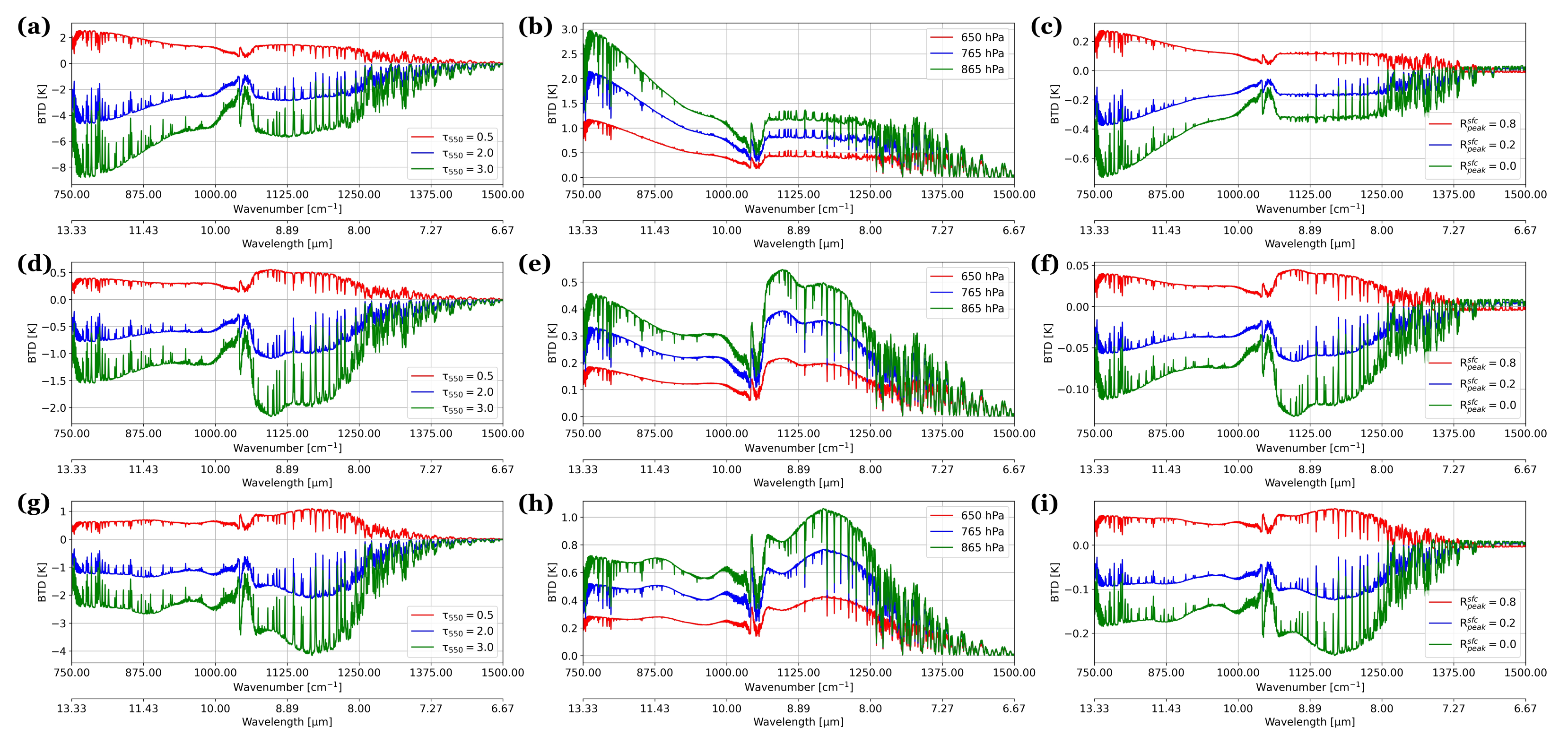
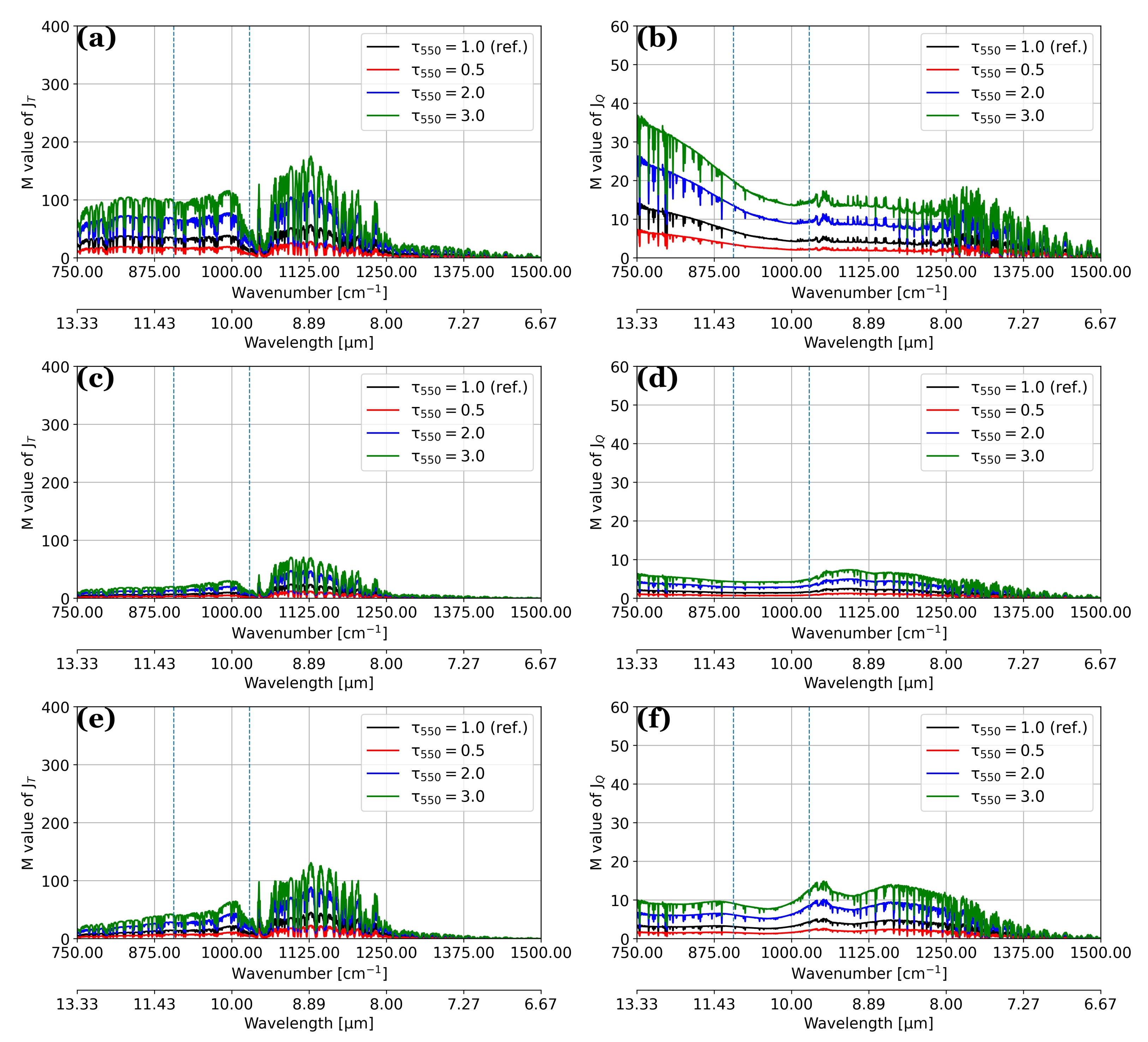
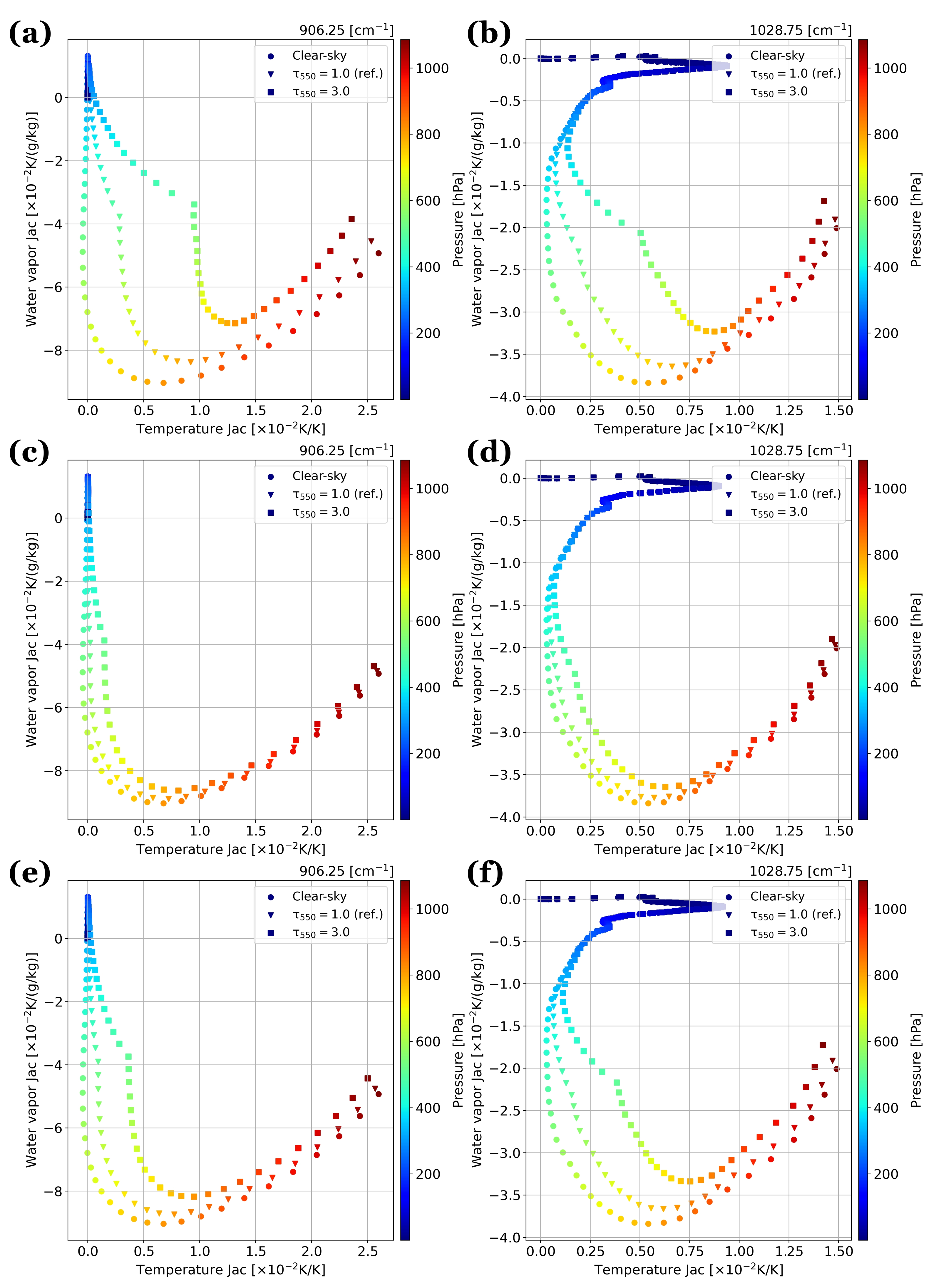
References
- Courtier, P.; Andersson, E.; Heckley, W.A.; Kelly, G.; Pailleux, J.; Rabier, F.; Thepaut, J.N.; Unden, P.; Vasiljevic, D.; Cardinali, C.; et al. Variational Assimilation at ECMWF; ECMWF Technical Memoranda; European Centre for Medium Range Weather Forecasts: Reading, UK, 1993; Volume 194. [Google Scholar]
- Eyre, J.R.; Kelly, G.A.; McNally, A.P.; Andersson, E.; Persson, A. Assimilation of TOVS Radiance Information through One-Dimensional Variational Analysis. Q. J. R. Meteorol. Soc. 1993, 119, 1427–1463. [Google Scholar] [CrossRef]
- Andersson, E.; Pailleux, J.; Thépaut, J.-N.; Eyre, J.R.; McNally, A.P.; Kelly, G.A.; Courtier, P. Use of Cloud-Cleared Radiances in Three/Four-Dimensional Variational Data Assimilation. Q. J. R. Meteorol. Soc. 1994, 120, 627–653. [Google Scholar] [CrossRef]
- Derber, J.C.; Wu, W.-S. The Use of TOVS Cloud-Cleared Radiances in the NCEP SSI Analysis System. Mon. Wea. Rev. 1998, 126, 2287–2299. [Google Scholar] [CrossRef]
- Courtier, P.; Andersson, E.; Heckley, W.; Vasiljevic, D.; Hamrud, M.; Hollingsworth, A.; Rabier, F.; Fisher, M.; Pailleux, J. The ECMWF Implementation of Three-Dimensional Variational Assimilation (3D-Var). I: Formulation. Q. J. R. Meteorol. Soc. 1998, 124, 1783–1807. [Google Scholar] [CrossRef]
- Saunders, R.; Hocking, J.; Turner, E.; Rayer, P.; Rundle, D.; Brunel, P.; Vidot, J.; Roquet, P.; Matricardi, M.; Geer, A.; et al. An Update on the RTTOV Fast Radiative Transfer Model (Currently at Version 12). Geosci. Model Dev. 2018, 11, 2717–2737. [Google Scholar] [CrossRef] [Green Version]
- Weng, F.; Han, Y.; van Delst, P.; Liu, Q.; Kleespies, T.; Yan, B.; Marshall, J.L. JCSDA Community Radiative Transfer Model (CRTM). In Proceedings of the 14th International TOVS Study Conference, BeiJing, China, 25–31 May 2005; p. 6. [Google Scholar]
- Han, Y.; van Delst, P.; Liu, Q.; Weng, F.; Yan, B.; Treadon, R.; Derber, J. JCSDA Community Radiative Transfer Model (CRTM)—Version 1; NOAA Technical Report NESDIS; National Oceanic and Atmospheric Administration National Environmental Satellite, Data, and Information Service: Washington, DC, USA, 2006; Volume 122. [Google Scholar]
- Sokolik, I.N. The spectral radiative signature of wind-blown mineral dust: Implications for remote sensing in the thermal IR region. Geophys. Res. Lett. 2002, 29, 7-1–7-4. [Google Scholar] [CrossRef] [Green Version]
- Pierangelo, C.; Chedin, A.; Heilliette, S.; Jacquinet-Husson, N.; Armante, R. Dust altitude and infrared optical depth from AIRS. Atmos. Chem. Phys. 2004, 4, 1813–1822. [Google Scholar] [CrossRef] [Green Version]
- Matricardi, M. The Inclusion of Aerosols and Clouds in RTIASI, the ECMWF Fast Radiative Transfer Model for the Infrared Atmospheric Sounding Interferometer; ECMWF Technical Memoranda; European Centre for Medium Range Weather Forecasts: Reading, UK, 2005; Volume 474. [Google Scholar]
- Quan, X.; Huang, H.-L.; Zhang, L.; Weisz, E.; Cao, X. Sensitive detection of aerosol effect on simulated IASI spectral radiance. J. Quant. Spectrosc. Radiat. Transf. 2013, 122, 214–232. [Google Scholar] [CrossRef]
- Hess, M.; Koepke, P.; Schult, I. Optical Properties of Aerosols and Clouds: The Software Package OPAC. Bull. Am. Meteorol. Soc. 1998, 79, 831–844. [Google Scholar] [CrossRef]
- Liu, Q.; Han, Y.; van Delst, P.; Weng, F. Modeling aerosol radiance for NCEP data assimilation. In Fourier Transform Spectroscopy/Hyperspectral Imaging and Sounding of the Environment; HThA5; Optical Society of America: Washington, DC, USA, 2007. [Google Scholar] [CrossRef]
- Chen, Y.; Han, Y.; Weng, F. Comparison of two transmittance algorithms in the community radiative transfer model: Application to AVHRR. J. Geophys. Res. Atmos. 2012, 117, D06206. [Google Scholar] [CrossRef] [Green Version]
- Weaver, C.J.; Joiner, J.; Ginoux, P. Mineral aerosol contamination of TIROS Operational Vertical Sounder (TOVS) temperature and moisture retrievals. J. Geophys. Res. 2003, 108, 4246. [Google Scholar] [CrossRef] [Green Version]
- Kim, J.; Akella, S.; da Silva, A.M.; Todling, R.; McCarty, W. Preliminary Evaluation of Influence of Aerosols on the Simulation of Brightness Temperature in the NASA’s Goddard Earth Observing System Atmospheric Data Assimilation System; Technical Report Series on Global Modeling and Data Assimilation; Goddard Space Flight Center; National Aeronautics and Space Administration: Greenbelt, MD, USA, 2018. [Google Scholar]
- Wei, S.-W.; Lu, C.-H.; Liu, Q.; Collard, A.; Zhu, T.; Grogan, D.; Li, X.; Wang, J.; Grumbine, R.; Bhattacharjee, P.S. The Impact of Aerosols on Satellite Radiance Data Assimilation Using NCEP Global Data Assimilation System. Atmos. 2021, 12, 432. [Google Scholar] [CrossRef]
- Liang, D.; Weng, F. Evaluation of the Impact of a New Quality Control Method on Assimilation of CrIS Data in HWRF-GSI. In Proceedings of the 2014 IEEE Geoscience and Remote Sensing Symposium, Quebec City, QC, Canada, 13–18 July 2014; pp. 3778–3781. [Google Scholar]
- Zhu, Y.; Derber, J.; Collard, A.; Dee, D.; Treadon, R.; Gayno, G.; Jung, J.A. Enhanced radiance bias correction in the National Centers for Environmental Prediction’s Gridpoint Statistical Interpolation data assimilation system: Radiance Bias Correction in GSI. Q. J. R. Meteorol. Soc. 2014, 140, 1479–1492. [Google Scholar] [CrossRef]
- Wu, W.-S.; Purser, R.J.; Parrish, D.F. Three-Dimensional Variational Analysis with Spatially Inhomogeneous Covariances. Mon. Wea. Rev. 2002, 130, 2905–2916. [Google Scholar] [CrossRef] [Green Version]
- Liu, Q.; Weng, F. Advanced Doubling—Adding Method for Radiative Transfer in Planetary Atmospheres. J. Atmos. Sci. 2006, 63, 3459–3465. [Google Scholar] [CrossRef]
- Chin, M.; Rood, R.B.; Lin, S.-J.; Müller, J.-F.; Thompson, A.M. Atmospheric sulfur cycle simulated in the global model GOCART: Model description and global properties. J. Geophys. Res. Atmos. 2000, 105, 24671–24687. [Google Scholar] [CrossRef]
- Colarco, P.; da Silva, A.; Chin, M.; Diehl, T. Online simulations of global aerosol distributions in the NASA GEOS-4 model and comparisons to satellite and ground-based aerosol optical depth. J. Geophys. Res. 2010, 115, D14207. [Google Scholar] [CrossRef] [Green Version]
- Liu, Q.; Lu, C.-H. Community Radiative Transfer Model for Air Quality Studies. In Light Scattering Reviews; Kokhanovsky, A., Ed.; Springer Praxis Books; Springer: Berlin/Heidelberg, Germany, 2016; Volume 11, pp. 67–115. [Google Scholar]
- Lu, C.-H.; Liu, Q.; Wei, S.-W.; Johnson, B.T.; Dang, C.; Stegmann, P.G.; Grogan, D.; Ge, G.; Hu, M. The Aerosol Module in the Community Radiative Transfer Model (v2.2 and v2.3): Accounting for Aerosol Transmittance Effects on the Radiance Observation Operator. Geosci. Model Dev. 2021. preprint. [Google Scholar] [CrossRef]
- Gelaro, R.; McCarty, W.; Suárez, M.J.; Todling, R.; Molod, A.; Takacs, L.; Randles, C.A.; Darmenov, A.; Bosilovich, M.G.; Reichle, R.; et al. The Modern-Era Retrospective Analysis for Research and Applications, Version 2 (MERRA-2). J. Clim. 2017, 30, 5419–5454. [Google Scholar] [CrossRef]
- Randles, C.A.; da Silva, A.M.; Buchard, V.; Colarco, P.R.; Darmenov, A.; Govindaraju, R.; Smirnov, A.; Holben, B.; Ferrare, R.; Hair, J.; et al. The MERRA-2 Aerosol Reanalysis, 1980 Onward. Part I: System Description and Data Assimilation Evaluation. J. Clim. 2017, 30, 6823–6850. [Google Scholar] [CrossRef]
- Garand, L.; Turner, D.S.; Larocque, M.; Bates, J.; Boukabara, S.; Brunel, P.; Chevallier, F.; Deblonde, G.; Engelen, R.; Hollingshead, M.; et al. Radiance and Jacobian Intercomparison of Radiative Transfer Models Applied to HIRS and AMSU Channels. J. Geophy. Res. Atmos. 2001, 106, 24017–24031. [Google Scholar] [CrossRef] [Green Version]
- Karyampudi, V.M.; Palm, S.P.; Reagen, J.A.; Fang, H.; Grant, W.B.; Hoff, R.M.; Moulin, C.; Pierce, H.F.; Torres, O.; Browell, E.V.; et al. Validation of the Saharan Dust Hgpti, Plume Conceptual Model Using Lidar, Meteosat, and ECMWF Data. Bull. Am. Meteor. Soc. 1999, 80, 1045–1076. [Google Scholar] [CrossRef] [Green Version]
- Hólm, E.; Andersson, E.; Beljaars, A.; Lopez, P.; Mahfouf, J.-F.; Simmons, A.; Thépaut, J.-N. Assimilation and Modelling of the Hydrological Cycle: ECMWF’s Status and Plans; ECMWF Technical Memoranda; European Centre for Medium Range Weather Forecasts: Reading, UK, 2002; Volume 383. [Google Scholar]
- Vandenbussche, S.; Kochenova, S.; Vandaele, A.C.; Kumps, N.; De Mazière, M. Retrieval of Desert Dust Aerosol Vertical Profiles from IASI Measurements in the TIR Atmospheric Window. Atmos. Meas. Technol. 2013, 6, 2577–2591. [Google Scholar] [CrossRef] [Green Version]
- Köhler, C.H.; Trautmann, T.; Lindermeir, E.; Vreeling, W.; Lieke, K.; Kandler, K.; Weinzierl, B.; Groß, S.; Tesche, M.; Wendisch, M. Thermal IR Radiative Properties of Mixed Mineral Dust and Biomass Aerosol during SAMUM-2. Tellus B Chem. Phys. Meteorol. 2011, 63, 751–769. [Google Scholar] [CrossRef] [Green Version]
- Grogan, D.; Lu, C.-H.; Wei, S.-W.; Chen, S.-P. Effects of Saharan dust on African easterly waves: The impact of aerosol-affected satellite radiances on data assimilation. Atmos. Chem. Phys. Disc. 2021, 1–30, preprint. [Google Scholar] [CrossRef]

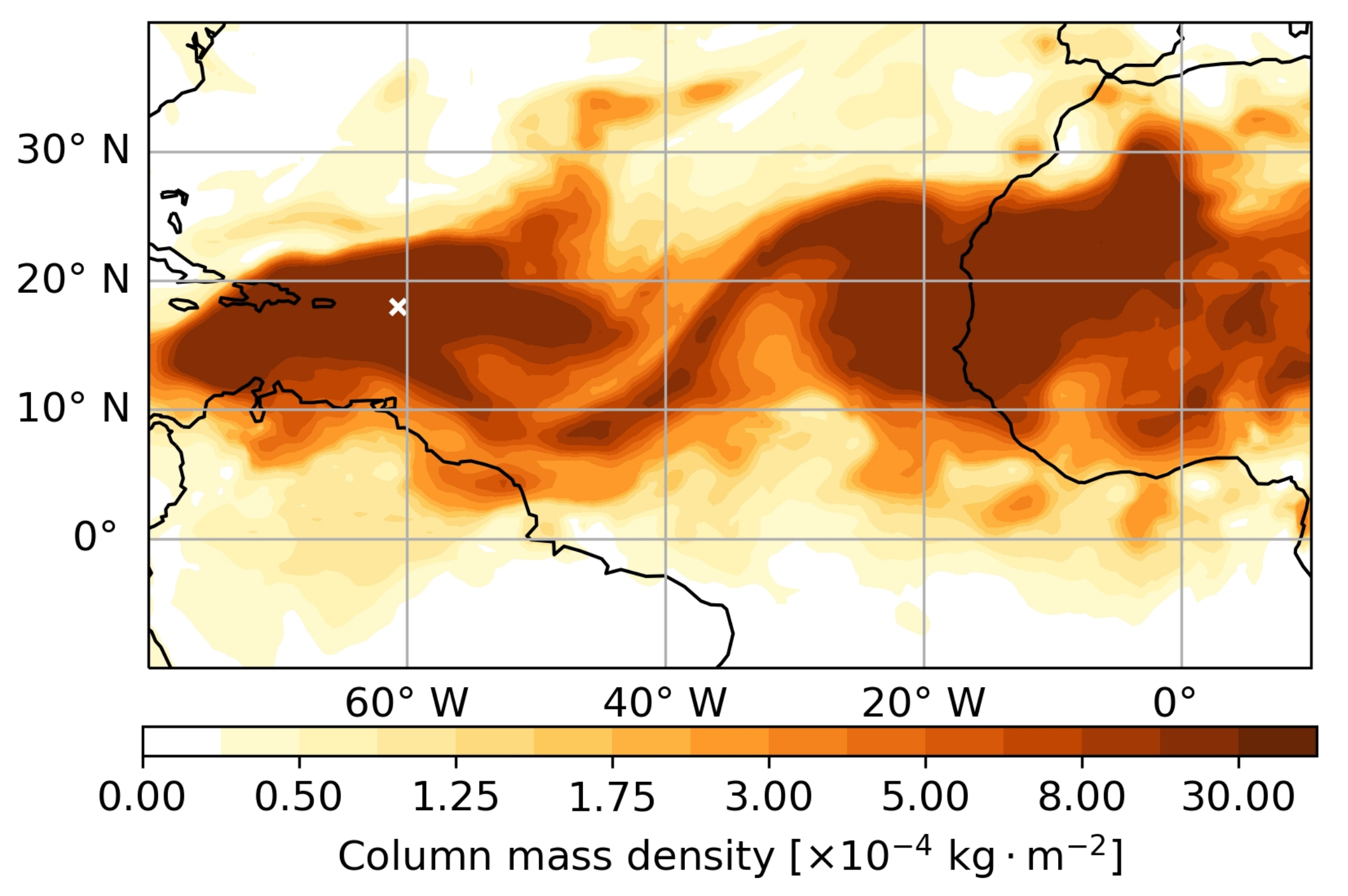
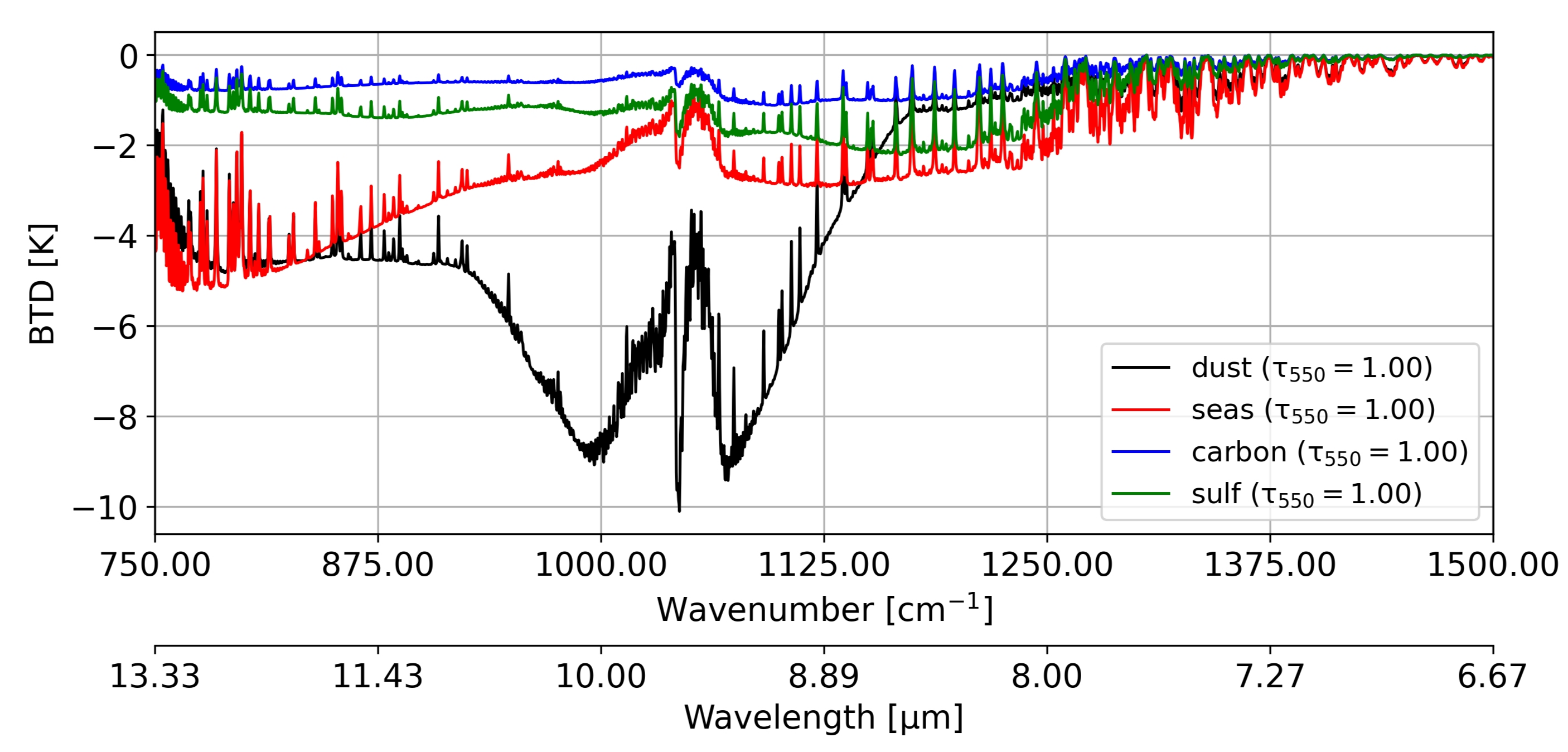
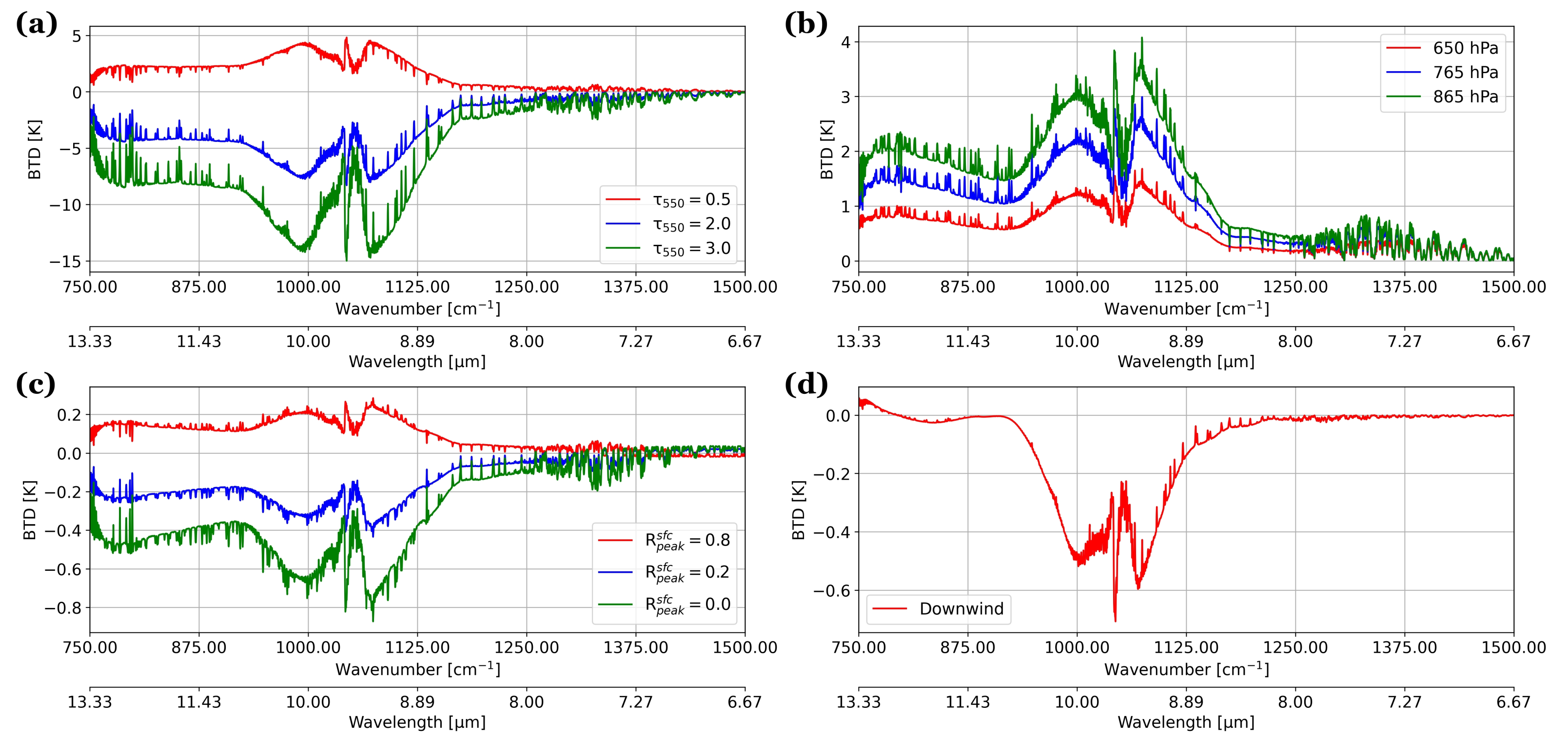



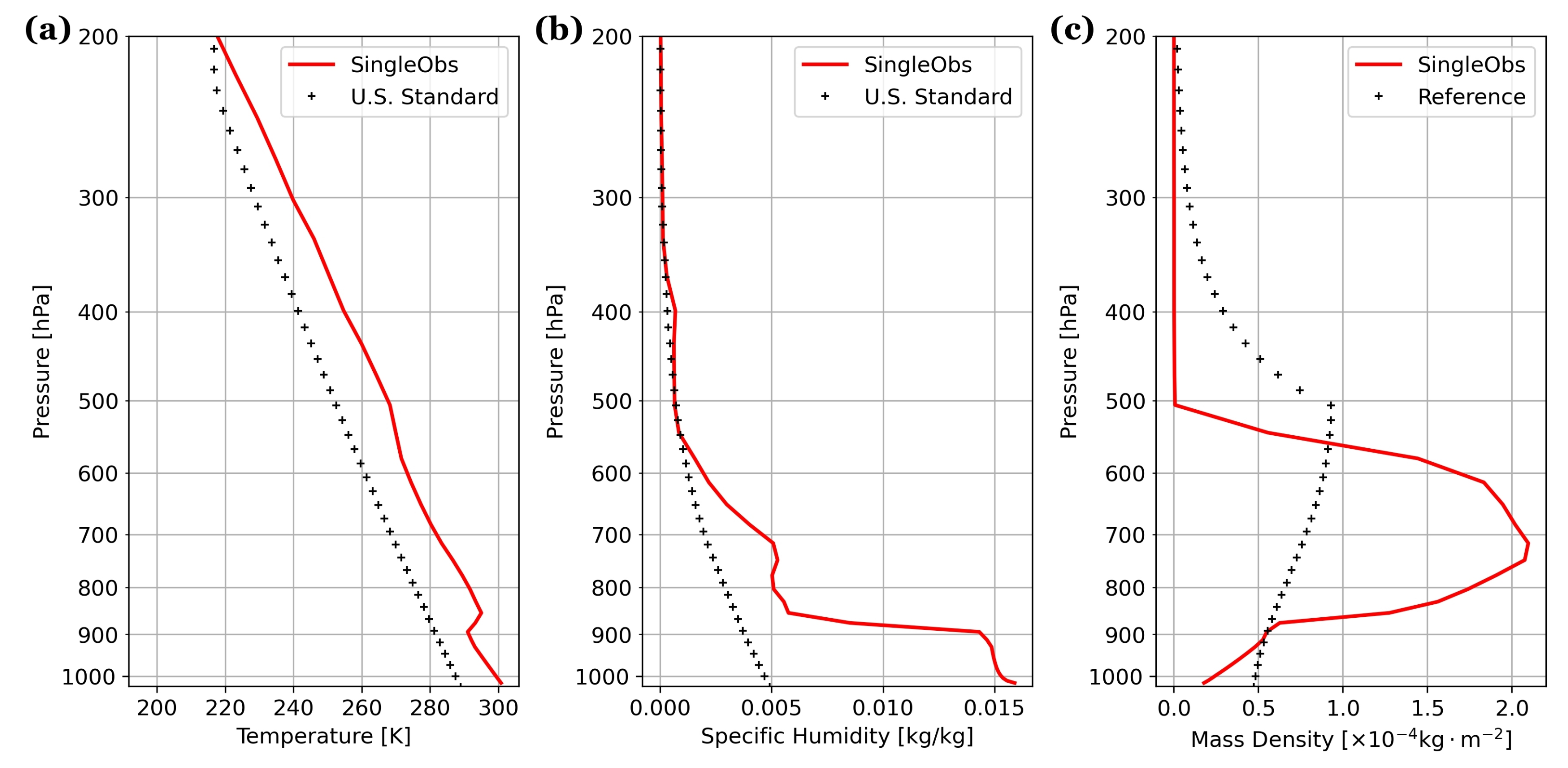
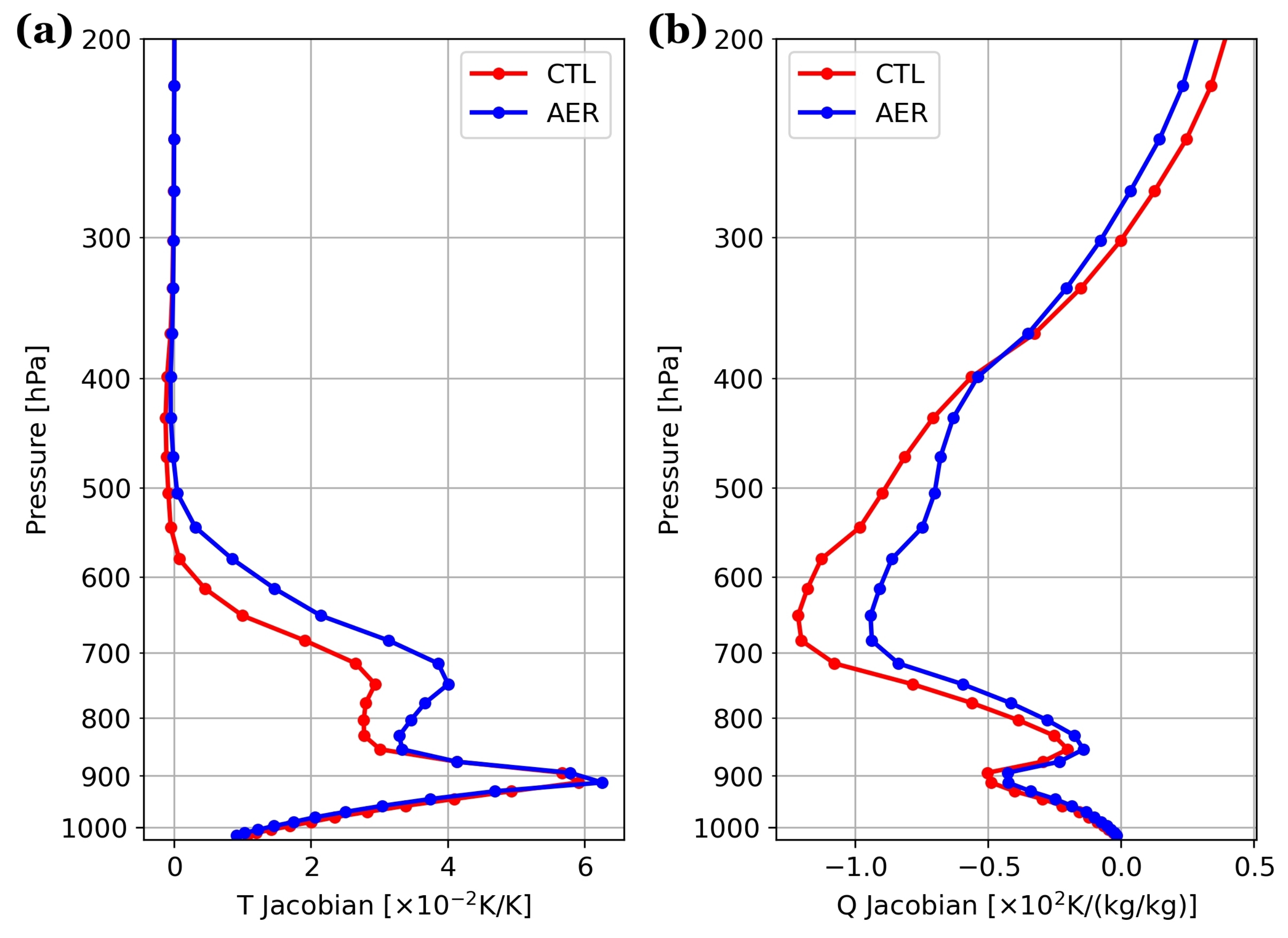
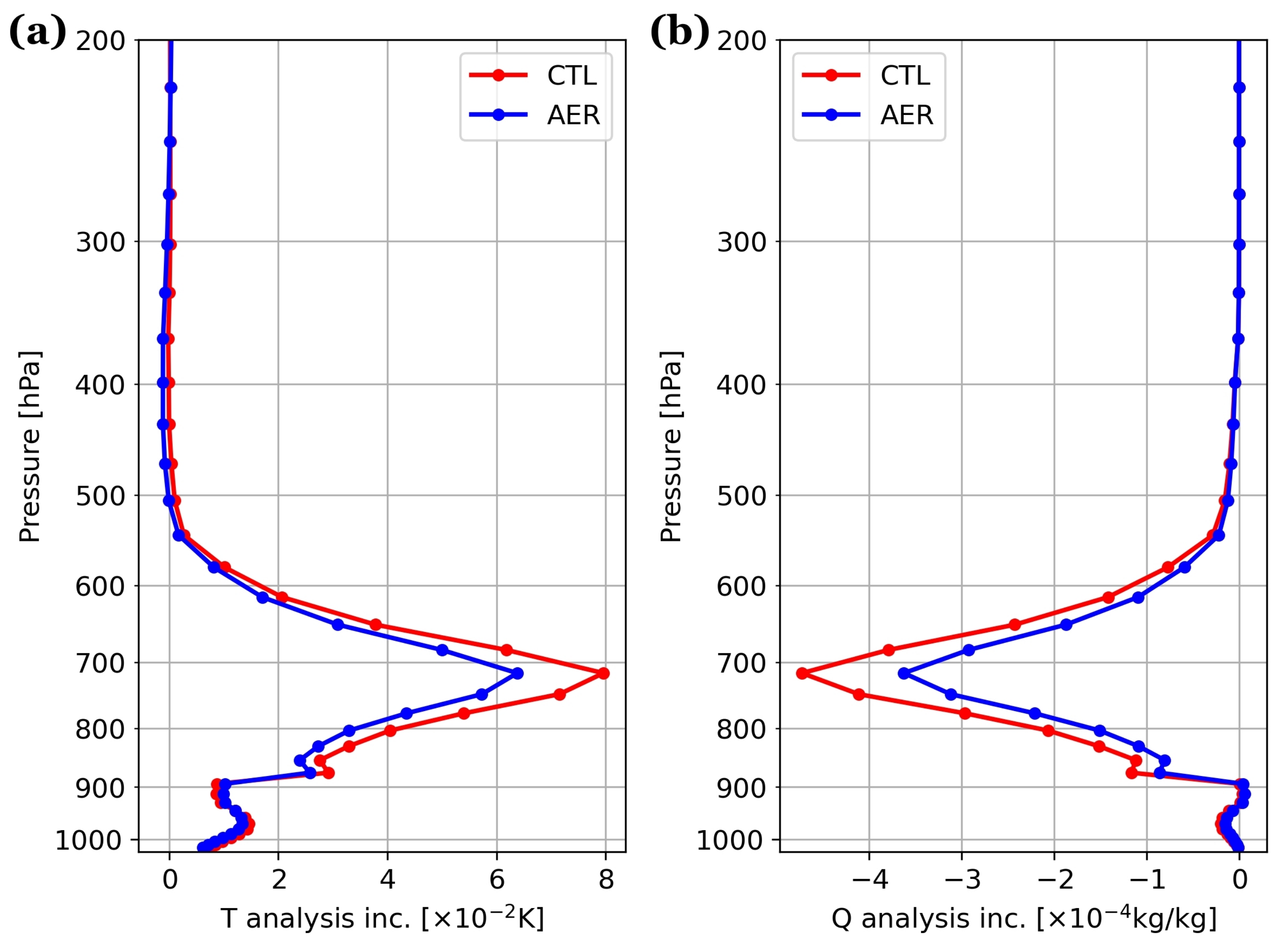
| Aerosol Profile Type | Corresponding Variable Name in MERRA-2 and Bin Partition | ||||
|---|---|---|---|---|---|
| Dust | DU001 | DU002 | DU003 | DU004 | DU005 |
| 10% | 30% | 40% | 15% | 5% | |
| Sea Salt | SS001+SS002 | SS003 | SS004 | SS005 | |
| 5% | 25% | 60% | 10% | ||
| Carbonaceous | OCPHOBIC | OCPHILIC | BCPHOBIC | BCPHILIC | |
| 15% | 75% | 5% | 10% | ||
| Sulfate | SO4 | ||||
| 100% | |||||
Publisher’s Note: MDPI stays neutral with regard to jurisdictional claims in published maps and institutional affiliations. |
© 2022 by the authors. Licensee MDPI, Basel, Switzerland. This article is an open access article distributed under the terms and conditions of the Creative Commons Attribution (CC BY) license (https://creativecommons.org/licenses/by/4.0/).
Share and Cite
Wei, S.-W.; Lu, C.-H.; Johnson, B.T.; Dang, C.; Stegmann, P.; Grogan, D.; Ge, G.; Hu, M. The Influence of Aerosols on Satellite Infrared Radiance Simulations and Jacobians: Numerical Experiments of CRTM and GSI. Remote Sens. 2022, 14, 683. https://doi.org/10.3390/rs14030683
Wei S-W, Lu C-H, Johnson BT, Dang C, Stegmann P, Grogan D, Ge G, Hu M. The Influence of Aerosols on Satellite Infrared Radiance Simulations and Jacobians: Numerical Experiments of CRTM and GSI. Remote Sensing. 2022; 14(3):683. https://doi.org/10.3390/rs14030683
Chicago/Turabian StyleWei, Shih-Wei, Cheng-Hsuan (Sarah) Lu, Benjamin T. Johnson, Cheng Dang, Patrick Stegmann, Dustin Grogan, Guoqing Ge, and Ming Hu. 2022. "The Influence of Aerosols on Satellite Infrared Radiance Simulations and Jacobians: Numerical Experiments of CRTM and GSI" Remote Sensing 14, no. 3: 683. https://doi.org/10.3390/rs14030683
APA StyleWei, S.-W., Lu, C.-H., Johnson, B. T., Dang, C., Stegmann, P., Grogan, D., Ge, G., & Hu, M. (2022). The Influence of Aerosols on Satellite Infrared Radiance Simulations and Jacobians: Numerical Experiments of CRTM and GSI. Remote Sensing, 14(3), 683. https://doi.org/10.3390/rs14030683







